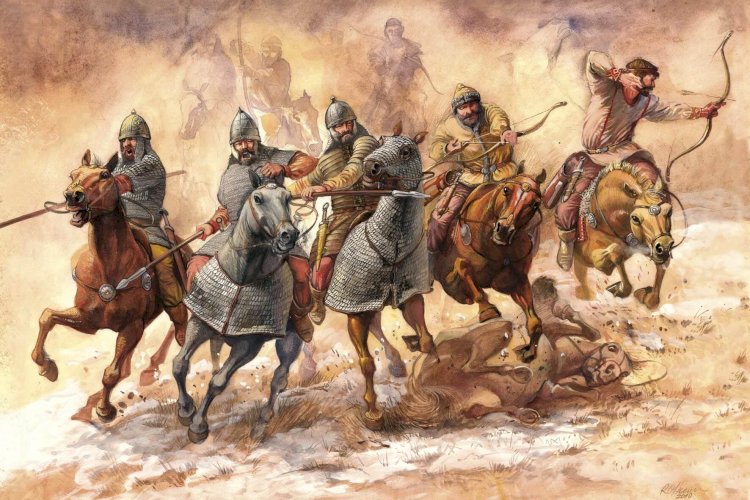After the fall of the Kimak Kaganate in Central Asia in 1050, the Kipchak Khanate was formed. It was located on the geographical territory of present Kazakhstan, except Semirechye. The lands of the former Kimak Kaganate by the XI century became part of the Kipchak Khanate. In the east, the Kipchak Khanate bordered on the Irtysh River, its western borders were along the Volga River, its southern borders reached Talas, and its northern borders reached the Siberian taiga.
Kipchak tribes mixed with neighbouring peoples, in particular with Turks and Oghuz. Researchers of the Kipchak culture believe that there were about 16 tribes of Kipchaks. By the second quarter of the 11th century, the Kipchaks were able to displace the Oghuz tribes that lived along the Syr Darya River, in the Aral Sea region and in the Caspian steppes. These tribes were able to capture the Mangyshlak peninsula and surrounding lands, and the borders of their possessions approached Khorezm.
According to evidence from Arab authors, the Kipchaks established certain nomadic routes in the steppe. The khan in this state was elected from a noble family of the Yelborili tribe.
The Kipchak Khanate reached the peak of its development by the middle of the XI century. Then nomadic tribes reached the steppes of the Black Sea region and reached the borders of Byzantium.
Mahmud Kashgari’s geographical map shows the movements of the Kipchaks by regions in the middle of the XI century. Their main places of residence at that time are indicated west of the Volga River and north-west of the Caspian Sea.

Mahmud Kashgari’s map translated into Turkish. The drawing is in the public domain.
The centre of government in the Kipchak Khanate was the khan’s headquarters. The headquarters of the left wing was located in the Sygnak city of Syr Darya. The right wing of the Kipchak state was located on the Ural River at the place of the town of Saraychik. Researchers believe that the centre of the Kipchak Khanate was located in the Turgai steppes. The territory of the Kipchak domains was conventionally divided into Desht-i-Kipchak East (from Irtysh to Volga) and Desht-i-Kipchak West (from Volga to Dniester).

Map of distribution of the Kipchak branch of the Turkic language in Central Asia. Photo from open sources on the Internet.
The Kipchak Khanate had complicated relations with the Karakhanid state, which often invaded the eastern regions of the Kipchak lands. The Seljuk ruler Alp-Arslan in 1065 made a campaign against the Kipchak state and captured Mangystau, but towards the end of the 11th century the Kipchaks managed to wrest this region from the Seljuks.
There was also a tense struggle between the Kipchaks and Khorezm. The Shah of Khorezm pursued a policy of weakening the Kipchak state. Khorezm Shah Atsyz several times raided the Oguzes, who at that time were subordinate to the Kipchaks. Further in 1133 Khorezmians won a victory over Kipchaks. But this victory of Khorezm Shah was not final. Kipchaks after the defeat of Khorezmians split into two tribal groups, which then significantly weakened them.
The Khorezmians realised that it would be difficult to defeat the Kipchaks in an open battle, and therefore decided to take advantage of internal contradictions among the Kipchak tribes. At the same time, the Khorezmians began to spread Islam among the Kipchaks.

Illustration from the book «Picturesque Karamzin». War with Polovtsians (Kipchaks). Drawing from open sources in the Internet.
Later, Khorezmshah during the internecine struggle between the khan of the Kipchaks Kadyr-Buka and his nephew Aliy-Derek decided to take possession of the city of Sygnak. With the support of the ruler of Otrar, the Khorezmians captured Sygnak in 1195.

Figure from the Radziwill Chronicle. Battle with Polovtsians (Kipchaks) on the river Alta in 1068. The photo is public domain.
Then between Khorezmshah Mohammed and the Kipchaks in the XIII century, there were several clashes in battles for power over the cities along the Syr Darya River. The Kipchaks were defeated due to lack of cohesion within their state. After the defeat, they retreated to the north, but the cities of Otrar and Sygnak continued to be sites of battles between the Kipchak Khanate and the Khorezm Shahs.
However, after the Mongols conquered the Central Asian region, the confrontation between the Kipchaks and Khorezmians ceased. The Kipchak Khanate ceased to exist after the Mongol conquests, and its territory subsequently became part of the ulus Dzhuchi. The Kipchaks are a very remarkable people who later played an important role in the history of many medieval states of Asia and Europe.
